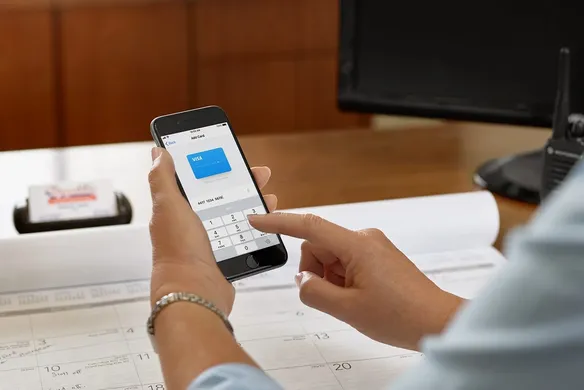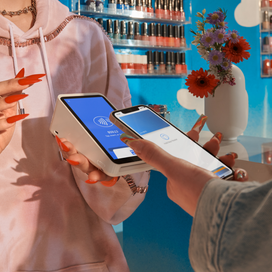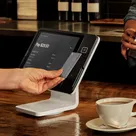Table of contents
If you’re not yet aboard the mobile commerce train, now is the time to hop on. As a business owner, it’s important to meet your consumers wherever they are. And what better place is there to meet your customers than on their mobile devices?
In a technological world with apps and games galore, we’re becoming more and more attached to our cell phones and tablets. Our devices go wherever we go, which is why mobile commerce is an excellent way for business owners to increase sales. In 2017, nearly one-third of online retail sales worldwide were generated through mobile apps. So what exactly is mobile commerce?
What is mobile commerce?
Mobile commerce, also known as mCommerce, is any kind of monetary transaction that occurs through a mobile device. It’s a fancy term for the routine things we do almost daily, such as sending our half of the restaurant bill to our friend through an app on our phones, or ordering a new book through the bookstore on our tablets.
What are the differences between mCommerce and eCommerce?
If you’re reading this, you’ve probably heard the term “eCommerce.” You also may be wondering what the difference is between eCommerce and mCommerce. Think of eCommerce as a tree with mCommerce extending from it like a branch. eCommerce is any monetary transaction done over the internet. mCommerce specifically refers to monetary transactions conducted through mobile devices.
3 different types of mobile commerce
Within the mobile commerce world, there are three types of mobile transactions:
- Mobile shopping: This includes any kind of shopping you do on your mobile devices, whether it’s ordering that new book from your tablet’s bookstore or buying household goods through an app on your phone.
- Mobile banking: Now think about the time you logged in to your bank’s mobile app to transfer your money from one account to another.
- Mobile payments: This includes any payments made via a mobile device, like using an app to send your half of the bill after dinner or Apple Pay or Google Pay to purchase your shopping. Mobile payments may also power mobile shopping and banking experiences.
What are the advantages and drawbacks of mCommerce?
One of the greatest advantages of mCommerce is the convenience it provides consumers. Consumers can shop whenever and wherever they want, which puts them in control and creates a better experience.
Here are the six biggest benefits of mobile commerce for business owners:
- Faster purchases: Consumers are able to browse and purchase products faster through mCommerce than eCommerce because there isn’t any need to pull data from a server.
- Better customer experience: With speed, convenience, interaction and exclusivity built into your mobile commerce app, customers are on track for a great shopping experience — one better than they might get in person or on the web.
- Connection to customers: With online shopping, you could send email to your customers. But with mCommerce, you can send push notifications directly to their mobile devices, which are already attached to their person.
- Tailored content: As a business owner, you can learn so much information about your customers through mCommerce, which helps create an even better and more personalised experience for them.
- Deeper analytics: With information such as your customer’s age, sex, location, and shopping history, you can make sure they see the products they love, which will encourage them to buy on the spot.
- Scalability: Mobile commerce allows you to better scale all parts of your business, whether it’s inventory or marketing. With marketing, for instance, you can use robust mobile data to ramp up marketing when you see interest spiking or waning.
As with anything, though, there are challenges to mCommerce:
- Need to optimise: As with all technology, mobile commerce is constantly evolving. You need to stay aware of those changes — advances in technologies, best practices, design, etc. — to ensure you always have an easy-to-use experience.
- Privacy concerns: Businesses that use mCommerce have more access to consumer data, and a responsibility to protect it. As with other forms of payment, you want to make sure you are PCI compliant and work with a processor that monitors for fraudulent activity. You also want to ensure that you know exactly how many of your partners access and use consumer data. Please consult a privacy professional on how best to remain compliant with all applicable privacy regulations.
- Easier to compare with competitors: One of the benefits of being online is that you can reach consumers that you might never reach otherwise. But that cuts both ways. Since it’s so easy to find businesses online, it’s also easier for customers to comparison shop. You need to keep up with your competitors — know what they sell and for how much — so you can find ways to compete.
- Damage to brick-and-mortar business: Some people worry that focusing on mobile commerce (or eCommerce generally) will hurt the performance of brick-and-mortar locations. The best way to avoid that is to treat mobile not as a separate experience but as an extension of more traditional experiences. Find ways to tie them together. Most consumers use mobile devices when they shop — even in-store — so use that to your advantage.
What are different mobile payment options?
Mobile payments are one type of mobile commerce. But even within that category there are different types of payment options.
Mobile wallets: A mobile wallet is a digital version of the wallet you keep in your purse or back pocket. It’s a convenient way to make purchases on your mobile device without physically swiping a card or handing over cash. Apple Pay and Google Pay are both examples of mobile wallets.
Mobile transfers: Mobile transfers are the services you usually receive through mobile banking apps, where you’re able to transfer money from one bank account to another with the push of a button on your mobile device. But you can also do this through peer-to-peer apps.
In-app payments: In-app payments occur through the convenient mobile apps of your favorite retailers. An in-app payment allows you to make purchases through an app you’ve downloaded to your mobile phone, smart watch, or tablet.
How to design an amazing mobile experience
When coming up with a mobile commerce strategy for your business, here are a few things you should consider:
Creating an app: When you create an app, you’re opening up a 24/7 relationship with your customers. You’re allowing them access to products and purchases at any time, and in any place. Rarely will you miss a sale if your customer can pull out their smartphone, log in to an app, and browse around until they’re ready to buy the items in their shopping cart.
That is, unless, your app experience is totally different from your eCommerce experience or just confusing. So when you create an app, think of it as an extension of your other purchasing channels. Use mobile best practices, but ensure that the look and feel matches your other experiences.
Integrating in-app payments: In-app payments make for a smooth, efficient, and speedy monetary transaction. Even if your customer is in your store, they can save time with the option to make a payment through an app on their phone versus waiting in a long line.
Remember, the customer experience should always come first. The overall shopping experience improves when customers can quickly purchase their items without waiting for acknowledgement or help from staff.
Load times: A lengthy load time on a mobile device is just as inconvenient as waiting in line at a store. We love using our smart devices because they are speedy. If a consumer has to wait around for your mobile app to load or process their payment, it creates a bad customer experience — and they’ll most likely leave the app without making the purchase.
What’s the future of mobile commerce?
The future of mobile commerce technology is endless. If you take a look at social media platforms such as Instagram, business owners are finding ways to advertise to their customers and encourage purchases while on social media apps.
And the ability to personalise notifications going straight to customers’ smart devices creates an intimacy between the customer and business owner. When business owners know exactly what their customers like, there’s increasing opportunity to make a sale. The only thing needed is the speed and convenience of mCommerce, which allows customers to make the purchase wherever they are.
![]()











